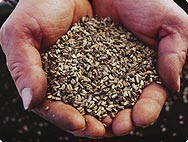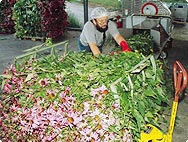
Echinacea purpurea (L.) Moench
Purple Coneflower

History
The genus name Echinacea derives from the Greek echinos (hedgehog) and refers to the thorny base of the flower head. Purpurea is Latin for ‘purple-red’.The coneflower was one of the most important healing plants of the Native Americans of the North American prairies, particularly the Cheyenne, Oglala-Lakota, Kiowa, Crow, Omaha, Pawnee, Ponca, Teton, Delaware, and Comanche. They used the juice or a mush made from the ground herb or chewed pieces of root. Decoctions were used less frequently. The traditional areas of use are numerous and include, among others, wounds, burns, inflammations of the gums, toothache and sore throats, colds, coughs, mumps, measles, and gonorrhoea. There are many reports of Echinacea being used to treat snake and insect bites and generally as an antidote for symptoms of poisoning. It can be assumed that the Native Americans did not distinguish between the individual species of Echinacea, but used the variety growing in their own respective region of settlement.North America’s white settlers adopted the use of the coneflower from the Native Americans. As early as 1737, the plant and its medicinal use were described by John Clayton in his Catalogue of Plants, Fruits, and Trees Native to Virginia. Subsequently, under the name Black Sampson, Echinacea was used as a panacea primarily by natural healers in lay medicine. In 1852, E. purpurea was listed in the Ecclectic Dispensatory of the United States for the first time and its successful use against syphilis claimed. The first pharmaceutical preparation was manufactured and sold around 1869 in Pawnee City by H.C.F. Meyer, who was of German origin, under the name «Meyer's Blood Purifier». Knowledge of Echinacea and reports of positive experience with it increased. But in 1909, recognition of the effectiveness of the purple coneflower was denied and it was not included in the list of «New and Non-Official Remedies». In 1911, the first comprehensive pharmaco-diagnostic papers on E. angustifolia were published with numerous drawings in microscopic detail. In the 1930s, interest in Echinacea waned in the United States and the number of articles published on it declined.
In Europe, the coneflower did not command respect until 1897. In 1900, Clarke described clinical successes in detail in his Dictionary of Practical Materia Medica, published in London. A homoeopathic medicine test was published in 1906, and, in 1924, E. angustifolia was included in Dr. Wilmar Schwabe's Homeopathic Medicine Book.Stauffer and Madaus helped prepare the way for the use of Echinacea in Europe [1]. Since then, morphological, pharmacological, and clinical research on the various Echinacea species has been intensive. The most intensively researched species is E. purpurea.Alfred Vogel first got to know the purple coneflower at the beginning of the 1950s while on a trip through the USA that took him to South Dakota. He became friends with the Dakota medicine man, Ben Black Elk who introduced him to the tribe's healing arts and made him a present of some Echinacea seeds. The plants grown from these seeds were the basis for Alfred Vogel's experiments with Echinacea, which became his most important healing plant.

Botanical characteristics
The purple coneflower is a perennial plant with relatively fine, branched roots, from which grows a 60 to 150 cm high, robust, branched stalk with sparse, rough hairs. The dark green, petiolate (stalked) basal leaves are ovate to ovate-lanceolate, pointed, and coarsely toothed. The somewhat smaller stalk leaves are coarsely toothed to entire, rough on both sides, and sit close to the stalk.The long-stalked, conically vaulted flower heads are 1.5 to 2.5 cm high and have a diameter of approx. 4 cm. The orange to dark red tubiflora, approx. 5 mm long, are surprisingly hard and gave the plant the name ‘hedgehog head’. The purple-red, hanging, tongued-shaped petals are 4cm to 6 cm long.The morphological characteristics of E. purpurea have been clearly distinguished (for example, ovate, toothed leaves; height; varied appearance; deep red, tongued flowers).In the first year, the purple coneflower blooms in September; in the following years, in July[1].

Habitat
The Echinacea family is native to the central and south-eastern parts of the United States. Some species, for example E. angustifolia, E. purpurea, and E. pallida, are widespread, while other species, such as E. laevigata, E. tennesseensis, and E. paradoxa, are found in narrowly restricted areas. E. tennesseensis is on the list of endangered plant species [1].E.purpurea prefers relatively damp sites in semi-shadow such as the edges of forests and embankments, from lowlands to elevations of 1500 metres.Adulterated Echinacea drugs are very common. E. angustifolia cultivated in Central Europe is usually E. pallida, which is not as difficult to cultivate [1]. By growing our own E. purpurea from our own seed stocks, as laid down by A.Vogel, Bioforce ensures quality and genetic uniformity while protecting the natural population from uncontrolled exploitation.

Preparation
A.Vogel uses alcoholic extracts from the fresh, aboveground parts of Echinacea purpurea harvested while and just before it flowers, as well as the original tincture from fresh roots of plants at least three years old, grown in organic cultivation. The homeopathic dilutions are manually potentised.The herb and root are also prepared as teas, juices, salves, and injection fluids. Some companies now produce Echinacea polysaccharides from tissue cultures on a mass scale in fermentation tanks. However, preparations produced in this way can no longer be called phytotherapeutic medicines.
A.Vogel Blog – Natural and Healthy
Inspiration for a healthy life!
HERBAMARE SOUP-ER SOUPS!
DOWNLOAD YOUR FREE RECIPE BOOKLET!
8 healthy, hearty and delicious homemade soups.
Supporting a healthier happier you
“Nature is just about the best thing we’ve got!“
Alfred Vogel's guide to leading a healthy and happy life
Healthy & nutritious dinner ideas
Get new recipes in your inbox every month. Sign up now